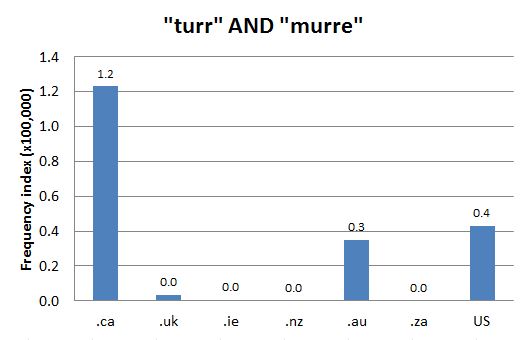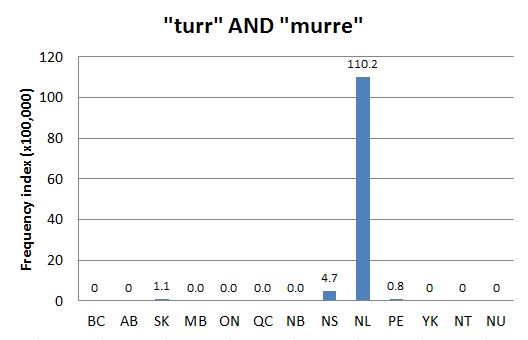DCHP-2
turr Turr, tuir DCHP-2 (November 2016)
n. — Newfoundland, Fauna
a name for two species of seabirds in the auk family, the common murre, also called the common guillemot, Uria aalge, and the thick-billed murre, Uria lomvia.
Type: 1. Origin — OED-3 (s.v. "turr") and ITP Nelson (s.v. "turr") suggest the term is imitative of "murre", the name for the common murre and the thick-billed murre. Clarke (2010b: 115) lists turr as one of several Newfoundland terms that appear to be inherited from another English dialect, yet to be determined. The term "murre" itself is indeed likely a preservation from British English, where it was used for any of three varieties of seabirds: the common guillemot, the razor-bill, Alca torda, or the puffin, Fratercula arctica (EDD, s.v. "murr(e)"). The razor-bill is usually called the tinker in Newfoundland (see tinker). DCHP-1 and Gage-3 define turr as including both the razor-bill and the murre, though evidence strongly suggests that Canadian usage of the term is restricted to the murre.
Though the birds were an important source of food in the past, diminishing populations have resulted in strict hunting regulations (see Department of Environment & Conservation reference). Turr is most frequent in Canada (see Chart 1), with Newfoundland accounting for the majority of hits (see Chart 2).
See also COD-2, s.v. "turr", which is marked "Cdn (Nfld)", ITP Nelson, s.v. "turr", which is marked "Newfoundland", Gage-5, s.v. "turr" which is marked "Nfld", DNE, s.v. "turr", and OED-3, s.v. "turr", which is marked "Newfoundland".See also: tinker (def. 1)
References:
Images:
Chart 1: Internet Domain Search, 14 Jul. 2014
Chart 2: Regional Domain Search, 14 Jul. 2014

